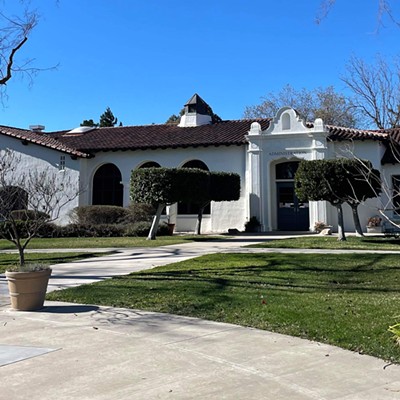January kicked us off with a rush of floodwater, and the rain didn’t stop until April. Certain areas of Santa Barbara County are still dealing with the ramifications from all that water and concerned about what the rainy season ahead has in store. The tension that started the year continued throughout the year, with fights over housing development, LGBTQ-plus issues, county ambulance contracts, carrots, and oil. While we don’t have the space to cover everything that happened in 2023, here are some of the highlights!
Historic storms, emergency cleanups

Severe winter storms drenched and flooded communities across Santa Barbara County in January. Jameson, Gibraltar, and Cachuma reservoirs reached capacity; a sinkhole formed in Orcutt; water wiped away Colson Canyon Road in Tepusquet; and the Santa Maria River veered off its natural path, flooding Guadalupe’s Pioneer Street. President Joe Biden approved an emergency declaration for Santa Barbara and San Luis Obispo counties—among several others—allowing the Federal Emergency Management Agency to assist with state and local response efforts to the storms. However, many projects remain ongoing or didn’t receive federal relief dollars. Guadalupe applied for a new water levee to prevent future flooding events but couldn’t receive federal or state relief because the project cost too much compared to what the levee would protect. As a result, the Santa Barbara County Board of Supervisors invested in an $8 million sediment removal project and built a 16-foot sand berm to temporarily protect Guadalupe from future flooding and is still working on getting a more permanent fix. In Tepusquet and beyond, the Los Padres Forest Service is working on repairing more than $100 million in storm damages to the nation’s third largest forest. Many access roads, like Colson Canyon Road, remain closed.
—Taylor O’Connor
Santa Maria, county plan to build
After years (decades, really) of stalled out planning, Santa Maria’s downtown is moving toward redevelopment. In 2023, Santa Maria City Council approved converting the old Fallas Department Store building into apartments and approved a six-story apartment building on Main Street and Broadway with space for restaurants and shops on the bottom story. The Vernon Group and others have plans with the city to bring almost 600 multifamily apartments (including affordable housing), ground floor retail spaces and restaurants, and outdoor gathering and recreational spaces to downtown, making it a walkable, lively place to live, work, and play. In addition to making moves on the city’s Downtown Specific Plan, Santa Maria is updating its general plan to make room for expansion. The city is looking at 985 acres east of the city to potentially annex in the future, as well as identifying areas for infill development within city limits where the city can accommodate for future growth. The city and its surrounding areas are ahead of South County when it comes to building and making room for housing. As part of California’s requirement to update Santa Barbara County’s Housing Element every eight years to comply with the state’s Regional Housing Needs Allocation, the county needs to make the space to build 5,664 units in unincorporated areas by 2031—10 times more than what it needed in the past cycle. North County needs space for 1,522 new units, while South County needs space for 4,142 new units. The county spent much of 2023 debating the Housing Element, ultimately passing it in mid-December with plans to start work on rezoning unincorporated areas to make room for housing development in 2024.
—Camillia Lanham
Santa Ynez Valley discrimination

FIGHTING FOR REPRESENTATION: After months of back and forth with Solvang City Council and facing backlash from community members, The Rainbow House Inc.’s proposal (founders Matt and Kiel Cavalli pictured) to hang Pride-themed banners was approved.
A proposal to hang Pride-themed banners in the city of Solvang during Pride Month in June launched a months-long, widespread debate that received international attention, and highlighted historic discrimination against the LGBTQ-plus community in the Danish-themed town. After the tumultuous months, the Solvang City Council approved LGBTQ-plus nonprofit The Rainbow House Inc.’s reapplication to hang redesigned Pride-themed banners for two weeks in June. However, the uproar continued in Santa Ynez Valley schools. Parents requested a parent’s rights policy from the Ballard Elementary School board after a fourth grader came out to her classmates as transgender. Parents were upset they weren’t notified ahead of the announcement, but according to the principal and superintendent of the school, the district protected the child in accordance with the law. Parents and other community members rallied against a student-led project painting Santa Ynez Valley High School crosswalks with a rainbow pattern for an anti-bullying week at school. It ultimately caused Santa Ynez Valley Union High School Principal Michael Niehoff to resign from his position after serving the school for a year—the fourth principal to leave in five years. The school district is still searching for a permanent replacement.
—Taylor
Cuyama groundwater adjudication, carrot boycott
A judge has yet to hear an adjudication lawsuit for groundwater rights two years after corporate carrot growers Bolthouse Farms and Grimmway Farms filed a lawsuit against more than 500 landowners in the Cuyama Valley. State law requires the community to bring the Cuyama Valley Groundwater Basin, one of the state’s 21 critically overdrafted groundwater basins, into sustainability through a groundwater sustainability plan and corresponding agency to monitor progress. With a state-approved groundwater sustainability plan—which calls for a 60 percent reduction in water use in 20 years—and an adjudication lawsuit, many Cuyama Valley residents are confused about how the two will impact one another. Landowners are worried about affording attorney fees as adjudication lawsuits typically drag on for decades. If they drop out of the lawsuit, they risk losing their groundwater rights altogether. As a result, several landowners launched a boycott against Big Carrot and a petition to drop the lawsuit. As of Dec. 21, 2023, 8,982 people had signed the petition.
—Taylor
Oil wells, pipelines, and politics
In early 2023, the California Department of Conservation (DOC) began cleaning up the messy legacy that Greka Oil Company—now known as HVI Cat Canyon Inc.—left behind in Cat Canyon. As part of the largest plugging and abandonment project in state history, the DOC’s Geologic Energy Management Division received $34 million from the state to plug 171 abandoned HVI oil wells. It’s an example of what many environmentalists see as the state’s failure to hold oil companies accountable for their infrastructure and the environmental disasters their operations can cause. Those disasters include the Refugio Beach oil spill in 2015, which leaked thousands of gallons of crude onto the beach and into the ocean after a Plains All-American Pipeline ruptured. The pipeline is still shut-off as are ExxonMobil’s offshore operations. After an attempt to truck oil failed in 2022, the oil giant sued the county over the decision. A federal judge ruled against Exxon in 2023. The oil giant also purchased the pipeline from Plains this year and was attempting to upgrade the pipeline’s valve technology, both of which received community backlash. The county denied the valve proposal. Exxon also withdrew its existing application to replace the pipeline in November, saying that existing federal and state environmental reviews indicate that restarting the existing pipeline is the “least likely environmentally damaging practical alternative.”
—Camillia
Overdoses at Pioneer Valley High School
An estimated nine drug-related incidents occurred at Pioneer Valley High School in the second half of the 2022-23 school year, with four related to pills, two in which opioid reversal medication Narcan was administered, and three from unknown drugs, according to the Santa Maria Police Department. Parents wanted better communication from the high school and the Santa Maria Joint Union High School District about the situation and its plans to mitigate overdose risks. Countywide, school districts implemented overdose mitigation strategies after a state bill passed allowing school sites to administer Narcan without a prescription, enabling school personnel to act immediately rather than waiting for emergency medical services to arrive. The change comes at a time where overdoses are the third leading cause of death in children in the United States, according to 2020 Centers for Disease Control data, and Santa Barbara County’s population impacted by opioids is shifting to a younger demographic.
—Taylor
County ambulance services
The Santa Barbara County Board of Supervisors voted to approve the Santa Barbara County Fire Department as the county’s next emergency medical services provider starting in March 2024. After the decision, current county emergency services provider American Medical Response (AMR) filed a lawsuit against Santa Barbara County—claiming that it violated state emergency medical services laws. Prior to the switch, Santa Barbara County had an exclusive contract agreement with AMR where the company acted as the sole provider for county residents. In 2019, the county issued a request for proposal to see what changes could be made. AMR and County Fire responded. An independent review panel scored AMR higher, but the county decided to switch to a nonexclusive services agreement in April 2023. This move set up a tiered system that allowed applicants to apply for specific ambulance services. County Fire won all three contracts. AMR officials are claiming that the county set up an exclusive system after moving to the nonexclusive agreement.
—Taylor
Year in Review was compiled by Editor Camillia Lanham. Send news tips to [email protected].

















